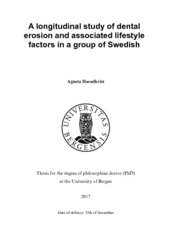| dc.contributor.author | Hasselkvist, Agneta | en_US |
| dc.date.accessioned | 2018-02-14T14:16:44Z | |
| dc.date.available | 2018-02-14T14:16:44Z | |
| dc.date.issued | 2017-12-15 | |
| dc.identifier.isbn | 978-82-308-3879-2 | en_US |
| dc.identifier.uri | https://hdl.handle.net/1956/17405 | |
| dc.description.abstract | Background: Erosive wear has been observed among Swedish adolescents, but with unknown prevalence. High prevalence of dental erosion is reported from different parts of the world, and often linked to an increasing consumption of soft drinks. Objective: The aim was to study the prevalence and progression of dental erosion among Swedish children and adolescents related to some health and lifestyle parameters, and to develop a simplified system for scoring dental erosion. Methods: 609 out of 801 individuals aged 5-6-, 13-14- and 18-19-years participated in the cross-sectional, prospective, longitudinal study, based on a clinical examination and questionnaires. 4-year progression was studied in the 13-14-year cohort. A Simplified Erosion Partial Recording System (SEPRS) was developed. The consumption of soft drinks was studied in relation to health and lifestyle. Results: Severe erosion was found in 13.3%, 11.9% and 22.3% of the respective groups. Correlation was found between soft drink consumption, male gender and severity of dental erosion. High soft drink consumers showed worse oral health and dietary and other unhealthy behaviors. After 4 years 32.3% of tooth surfaces had deteriorated by one grade and 2.6% by two grades. SEPRS showed 100% sensitivity and 98% specificity for detecting severe erosion in permanent teeth, and 100% each for primary teeth. Conclusion: Dental erosion was common among Swedish adolescents, especially among males. The high prevalence and progression was associated with worse oral health and some less healthy lifestyle factors. The simplified recording system, SEPRS, is a useful tool for screening for dental erosion in these age groups. Consequences: In view of the high prevalence of dental erosion and soft drink consumption among Swedish adolescents, there is a need to introduce community- based preventive programs from early ages as well as epidemiological recording of dental erosion. | en_US |
| dc.language.iso | eng | eng |
| dc.publisher | The University of Bergen | eng |
| dc.relation.haspart | Paper I. Hasselkvist A, Johansson A, Johansson AK. Dental erosion and soft drink consumption in Swedish children and adolescents and the development of a simplified erosion partial recording system. Swed Dent J 2010;34:187-95. <a href="http://hdl.handle.net/1956/17503" target="blank">http://hdl.handle.net/1956/17503</a> | en_US |
| dc.relation.haspart | Paper II. Hasselkvist A, Johansson A, Johansson AK. Association between soft drink consumption, oral health and some lifestyle factors in Swedish adolescents. Acta Odontol Scand 2014;72:1039-46. Full-text not available due to publisher's restrictions. The published version is available here: <a href="https://doi.org/10.3109/00016357.2014.946964" target="blank">https://doi.org/10.3109/00016357.2014.946964</a> | en_US |
| dc.relation.haspart | Paper III. Hasselkvist A, Johansson A, Johansson AK. A 4 year prospective longitudinal study of progression of dental erosion associated to lifestyle in 13-14 year-old Swedish adolescents. J Dent 2016;47:55-62. <a href="http://hdl.handle.net/1956/15621" target="blank">http://hdl.handle.net/1956/15621</a> | en_US |
| dc.title | A longitudinal study of dental erosion and associated lifestyle factors in a group of Swedish children and adolescents | en_US |
| dc.type | Doctoral thesis | |
| dc.rights.holder | Copyright the author. All rights reserved. | |
| dc.subject.nsi | VDP::Medisinske Fag: 700::Klinisk odontologiske fag: 830 | en_US |
